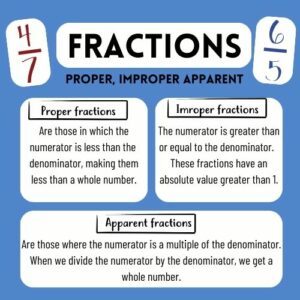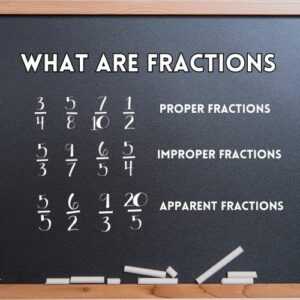Proper Fractions
Table of Contents
Proper fractions are those in which the numerator is less than the denominator, making them less than a whole number.
Apparent Fractions
Apparent fractions are those where the numerator is a multiple of the denominator. When we divide the numerator by the denominator, we get a whole number.
Examples:
- 6/3 (2 is a multiple of 3)
- 15/5 (3 is a multiple of 5)
- 24/8 (3 is a multiple of 8)
- The denominator exactly divides the numerator, resulting in a remainder of zero (0).
How to Identify Proper, Improper, and Apparent Fractions?

Proper and Improper Fractions
A fraction is considered proper if its numerator is less than its denominator, and improper if its numerator is greater than its denominator.
Differentiating Proper and Improper Fractions
Considering fractions as proportional relationships between two numbers, we establish a differentiation between those that exceed the unit (improper fractions) and those that do not (proper fractions).
Examples:
- 3/4
- 11/21
- 50/18
What is a Proper Fraction?
A proper fraction is one where the numerator is less than the denominator. In other words, the number at the top is smaller than the number at the bottom. This is the opposite of an improper fraction, where the numerator is greater than the denominator.
Examples:
- 1/2
- 3/4
- 2/5
- 5/8
Proper Fractions Definition
Proper fractions result from the division between two numbers, where the numerator (top number) is less than the denominator (bottom number).
Examples:
- 3/4
- 20/73
- 6/21
- 64/133

The Meaning of a Fraction
A fraction represents the parts of a whole. It signifies dividing something into equal parts and selecting a specific amount of it.
Etymologically, the term ‘fraction’ is of Latin origin, ‘fractio’, which means a breaking action.
Improper Fractions Definition
An improper fraction is a fraction in which the numerator (top number) is greater than or equal to the denominator (bottom number). Fractions like 6/5 or 11/4 are considered “improper.” These fractions have an absolute value greater than 1.
Examples:
- 6/5
- 11/4
- 7/3
- 10/2
- 15/5
Proper vs. Improper Fractions
Proper and improper fractions are operated on in similar ways. However, there are distinct characteristics that differentiate one from the other. For instance, multiplication between improper fractions yields an improper fraction as a result. Division by improper fractions depends on…
General Rule for Operations with Proper Fractions
Proper fractions result from the division between two numbers, where the numerator (also called the dividend) is less than the denominator (also called the divisor, located below the fractional line).
Unlike improper fractions, proper fractions cannot be expressed as a combination of a whole number and a fractional number, as this would imply the whole number is zero. Operations involving proper fractions follow the general rules for operations between fractions.
What are Fractions?

Fractions are the representation of the parts of a whole. This means that when dividing something into equal parts and selecting a certain amount of it, we represent it using fractions.